Plunge into the depths of biblical banquets to uncover their rich symbolism and the promise of divine celebration that awaits.
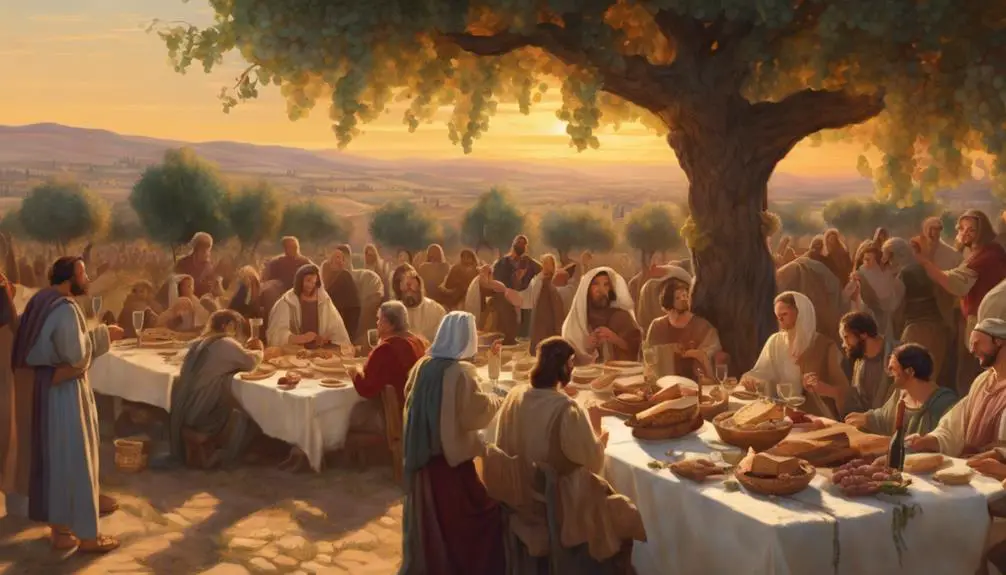
Banqueting Meaning in the Bible
Just as the Prodigal Son was welcomed back with a grand feast, banqueting in the Bible often symbolizes more than just a communal meal; it's a profound expression of joy, fellowship, and divine provision.
You'll find that these biblical feasts aren't merely historical accounts or cultural practices; they're rich with symbolism, reflecting themes of redemption, unity, and eschatological hope.
As you explore the layers of meaning behind these sacred gatherings, you'll uncover insights into how they shape our understanding of community, celebration, and the anticipation of the ultimate banquet.
This journey promises to enrich your perception of biblical narratives and their relevance to contemporary life.
Key Takeaways
- Banquets in the Bible symbolize divine provision, unity, and celebration within a spiritual and communal context.
- These feasts embody eschatological hope, pointing towards a future divine fulfillment and communal restoration.
- Table etiquette and guest inclusion at biblical banquets reflect societal norms, values, and the dynamics of divine invitation.
- The eschatological banquet emphasizes universal inclusion, showcasing the expansive nature of God's grace and the promise of eternal celebration.
Historical Context of Biblical Banquets
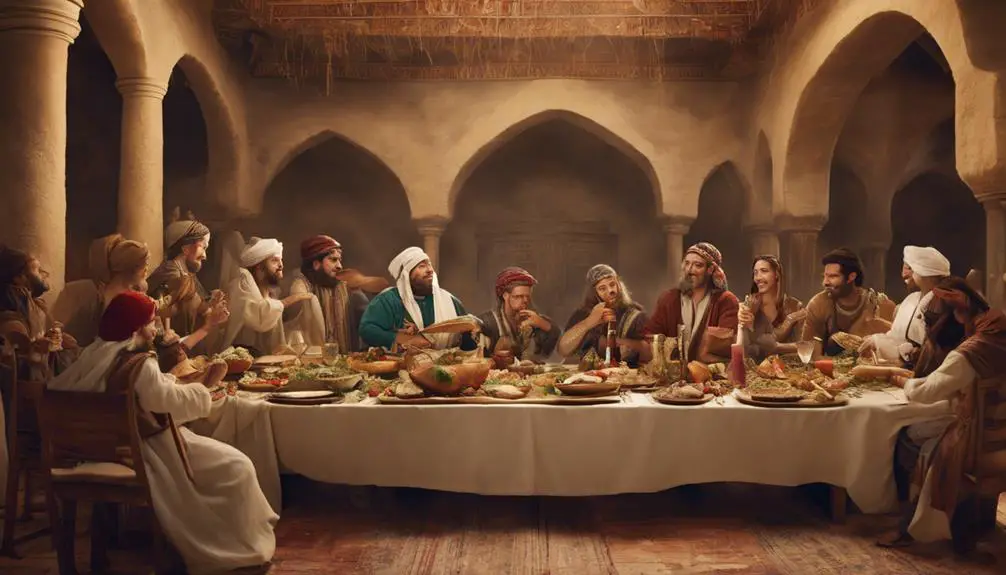
To understand the role and significance of banquets in the Bible, it's crucial to examine their historical context and how they reflected the social and religious landscapes of the time. Banquets weren't merely gatherings for food and drink; they were complex ceremonies woven into the fabric of ancient societies, serving as a mirror to their values, beliefs, and social hierarchies.
Feast regulations played a pivotal role in ensuring these events adhered to societal and religious norms. You'd find that these rules covered a wide array of aspects, from the types of food that could be served, based on dietary laws, to the sequence of events during the banquet itself. These regulations weren't trifling matters; they were imbued with deep theological significance, reflecting a community's covenant with the divine. For instance, the Passover meal wasn't just a family gathering but a ritual reenactment of the Israelites' liberation from Egypt, laden with symbolic foods and actions prescribed by religious law.
Guest etiquette, on the other hand, revealed the intricate social dynamics at play. How you were seated, the manner in which you ate, and even your behavior at these gatherings spoke volumes about your social standing and the respect you commanded within the community. These customs ensured that the social fabric remained intact, reinforcing hierarchies and cementing alliances.
Symbolism in Feast Imagery

Within the tapestry of biblical narratives, feast imagery serves as a profound symbol, reflecting deeper spiritual truths and divine promises. This richness of banquet scenes isn't merely about historical practices but illuminates the spiritual dimension, embodying feast metaphors with ritual significance.
Here's how:
- Unity and Fellowship: Banquets in the Bible symbolize a divine call to unity. They're not just social gatherings but profound expressions of community and fellowship among believers. This unity is further highlighted through the act of sharing a meal, which in ancient times, was a significant sign of friendship and communal harmony.
- Covenant Relationship: Feast imagery often represents the covenant relationship between God and His people. Just as a feast celebrates abundance and joy, it metaphorically signifies the richness of the divine covenant, overflowing with mercy and grace.
- Spiritual Nourishment: Beyond physical sustenance, biblical banquets symbolize spiritual nourishment. They remind you that man doesn't live on bread alone but thrives on every word that comes from the mouth of God. This feast metaphor underlines the ritual significance of being fed spiritually by the divine.
- Eschatological Hope: Finally, feast imagery in the Bible points to eschatological hope, anticipating the ultimate banquet in the Kingdom of God. This not only symbolizes the culmination of God's redemptive history but also the fulfillment of divine promises, where mourning turns into joy, and scarcity into abundance.
Through these vivid feast metaphors, the Bible intricately weaves the ritual significance of banquets into its narrative, guiding you to understand deeper spiritual realities and divine truths.
Divine Provision and Celebration
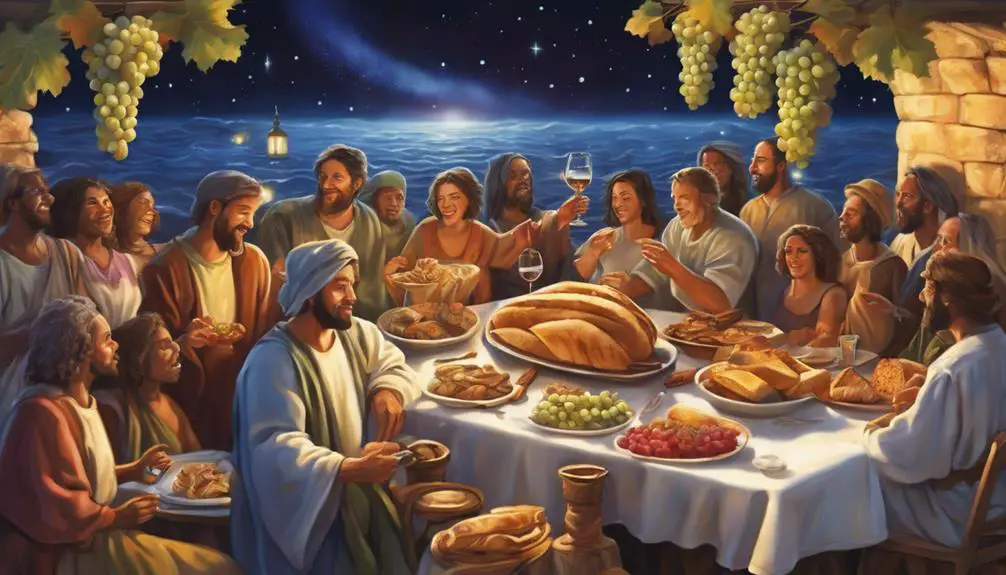
Banquets in the Bible often represent divine provision and celebration, illustrating how God generously meets the needs of His people and invites them to partake in joyous fellowship. This motif not only showcases the abundance of God's kindness but also serves as a theological symbol of divine-human interaction. The narratives of miraculous feedings stand out as prime examples, where the multiplication of loaves and fishes underscores God's ability to provide beyond human expectations. These instances aren't merely about the physical nourishment but also symbolize spiritual sustenance, highlighting the idea that God's provision encompasses all aspects of life.
Furthermore, the concept of fasting contrasts sharply with banqueting, offering a complementary perspective on divine provision and celebration. Fasting, as presented in biblical texts, often precedes moments of divine revelation or acts as a preparation for entering into a deeper relationship with God. It represents a deliberate abstinence to focus on spiritual matters, suggesting that divine provision isn't limited to material abundance but includes spiritual enrichment. This contrast between fasting and feasting enriches the understanding of banquets in the Bible, illustrating that celebration and divine provision are multifaceted, encompassing both physical sustenance and spiritual fulfillment.
Analyzing these elements reveals that biblical banquets aren't just social gatherings but are imbued with profound theological significance. They serve as a reminder of God's omnipotence and benevolence, reinforcing the belief in a deity who not only provides for but also celebrates with His creation.
Community and Unity at the Table
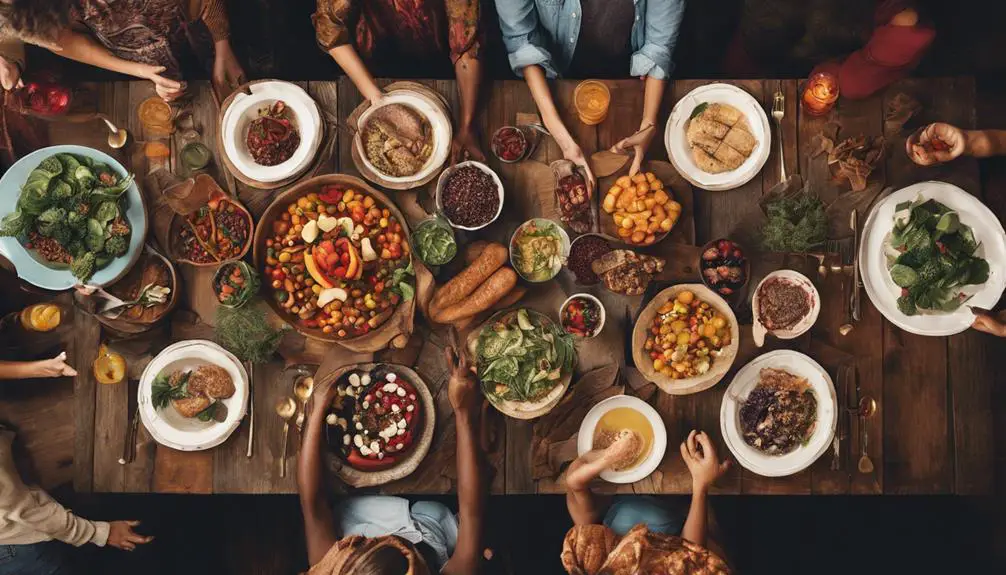
While exploring the theological significance of banquets in the Bible, it's crucial to examine how these gatherings foster community and unity among participants. These events aren't just about food; they're deeply embedded with cultural norms and table etiquette that speak volumes about the society's values. Let's delve into how biblical banquets serve as a microcosm for broader community dynamics:
- Inclusion and Exclusion: Biblical banquets often delineate who's in and who's out, reflecting societal structures. The act of inviting someone to a table can symbolize acceptance into a community, whereas exclusion mirrors societal rejection. This dynamic underscores the importance of unity and the pain of division within biblical contexts.
- Table Etiquette: The manners and customs observed during these meals reveal much about the era's cultural norms. For instance, washing one's feet before dining or the seating arrangement spoke volumes about one's social status and respect among peers. Such practices weren't mere formalities but deeply ingrained rituals that fostered a sense of belonging and respect.
- Shared Meals as Covenant Renewal: Participating in a banquet could symbolize the renewal of covenants, both divine and human. By breaking bread together, participants reaffirmed their commitments to one another and to God, strengthening the communal bonds.
- Symbolic Actions: Actions performed at the table, such as breaking bread or sharing wine, were laden with symbolic meaning. These actions didn't just foster a sense of unity among the participants; they also connected the community to its historical and spiritual roots.
The Eschatological Banquet
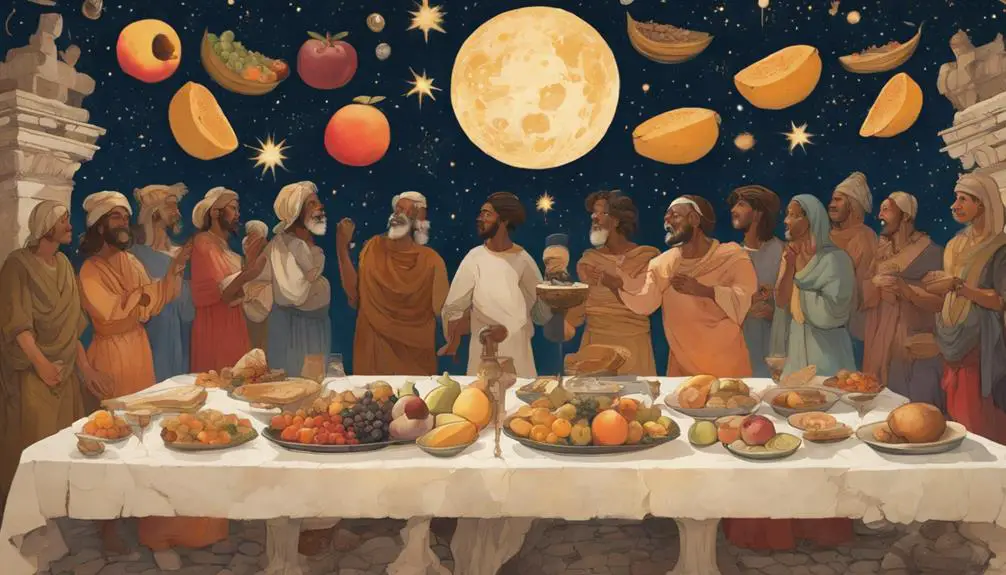
The concept of the eschatological banquet unfolds a profound narrative in biblical eschatology, inviting believers to envision a future marked by divine fulfillment and communal restoration. At its core, this theme intertwines with Messianic expectations and prophetic visions, presenting a future where harmony and divine presence are manifest at a grand, celestial feast.
To delve deeper, consider the richness of this theme through the following aspects:
Aspect |
Description |
Biblical References |
|---|---|---|
Divine Host |
God Himself invites and gathers the redeemed. |
Isaiah 25:6-9 |
Universal Invitation |
The banquet symbolizes inclusion, extending beyond Israel to all nations. |
Matthew 22:1-14 |
Prophetic Fulfillment |
The banquet serves as the fulfillment of prophecies, heralding the Messiah's reign. |
Luke 14:15-24 |
Analyzing these elements, you'll notice that the eschatological banquet isn't just an event; it's a fulfillment of deep-seated longings and divine promises. The imagery of a feast, so central to human experience, becomes a powerful metaphor for the ultimate reconciliation and joy found in God's kingdom. This convergence of divine invitation and universal inclusion underscores the expansive nature of God's grace, challenging you to reimagine the scope of salvation and the future of God's kingdom.
Through this lens, the eschatological banquet transcends mere historical or cultural interest, becoming a vibrant, living hope. It beckons you to see beyond the immediate, towards a horizon filled with the glory of prophetic visions and the realization of Messianic expectations—a future where every tear is wiped away, and the table is set for an eternal, divine celebration.
Frequently Asked Questions
How Did Dietary Laws Influence the Menu at Biblical Banquets?
You'll find that dietary laws significantly shaped the menu at biblical banquets. These regulations, centered on ceremonial cleanliness and the inclusion of sacrificial offerings, dictated what could be served.
Foods deemed clean according to Levitical laws were considered fit for consumption, affecting the variety and preparation of dishes. This adherence to dietary prescriptions not only demonstrated piety but also reinforced social and religious identity among participants.
Were There Any Notable Differences in Banqueting Customs Between the Old and New Testaments?
Yes, there were notable differences in banqueting customs between the Old and New Testaments. In the Old Testament, feasting practices were heavily influenced by dietary laws and cultural symbolism, reflecting a community's covenant with God.
In contrast, the New Testament portrays banquets as more inclusive, symbolizing the breaking down of barriers and welcoming all, regardless of social status. This shift illustrates a broader, more universal approach to community and fellowship in the New Testament.
How Did the Role and Social Status of Women Affect Their Participation in Biblical Banquets?
In societal gatherings, women's participation was like threading a needle—meticulous and defined by strict norms. Women's attire and conversation rules heavily influenced their roles. They were often sidelined, their status dictating their visibility and audibility at these events.
Analyzing historical texts, it's clear that the social fabric wove women into a corner of silence and adornment, limiting their engagement in dialogue and decision-making, reflecting broader societal views on gender roles.
What Were the Consequences of Over-Indulgence or Inappropriate Behavior at Biblical Feasts?
At biblical feasts, over-indulgence or inappropriate behavior wasn't just frowned upon; it carried deeper implications. These events, rich in feast symbolism, weren't merely social gatherings but were intertwined with moral teachings.
You'd find that excessive behavior often led to dire consequences, serving as practical lessons in self-control and morality. These narratives underscored the importance of moderation, illustrating how personal conduct could align or clash with wider societal values.
How Did Biblical Banquets Address or Reflect the Needs and Inclusion of the Poor and Marginalized Within Society?
In ancient feasts, you'd find a tapestry of society, where feast symbolism wove threads of social unity. These gatherings didn't just fill stomachs; they addressed societal gaps, inviting the poor and marginalized to the table.
Analyzing these events, you'd see a deliberate effort to mend the fabric of community, ensuring no thread—no matter how frayed—was left out. This inclusivity wasn't just tradition; it was a critical reflection of societal values and compassion.
Conclusion
In the tapestry of biblical texts, banquets unfold as multifaceted symbols of divine bounty, communal harmony, and eschatological hope.
You see, these meals don't just nourish the body; they weave individuals into a unified community, foreshadowing an eternal feast where scarcity and division are no more.
Through this lens, every shared meal becomes a sacrament of sorts, a tangible reminder of God's provision, the unity of believers, and the promised culmination of history's grand narrative in the heavenly banquet.



Sign up